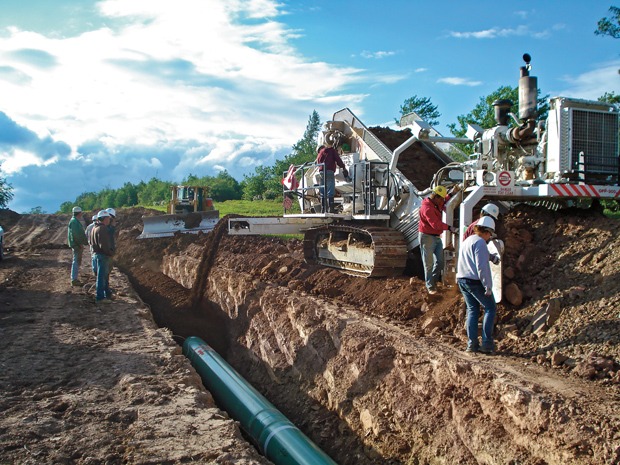Power companies urge Senate energy committee to fix regulatory ‘dogpile’

Innumerable, disjointed federal regulatory processes are hampering the ability of U.S. power companies to modernize America’s energy infrastructure.
The result has been money-sucking, delayed projects and lost opportunities for job growth, economic development and investments, among others – not to mention the stalled creation or upgrade of cleaner-operating, cost-efficient, more technologically secure powerhouses, said witnesses who testified March 14 to members of the Senate Energy and Natural Resources Committee.
In fact, a common thread between testimonies was that coordination among several federal agencies is critical to the timely review of a project. However, industry executives bemoaned the lack of it.
“As designed today, the federal permitting process is challenging,” said Diane Leopold, president and chief executive officer of Dominion Energy, the business unit of Dominion Resources that handles all of the company’s natural gas operations.
A case in point is the joint venture project between Dominion, Duke Energy, Piedmont Natural Gas, and Southern Company Gas to build the 600-mile, $5 billion, 100-percent privately financed, underground Atlantic Coast Pipeline (ACP). The ACP will bring 1.5 billion cubic feet per day of new supplies of natural gas to gas-constrained areas of Virginia and North Carolina. The pre-filing process with the Federal Energy Regulatory Commission (FERC) started in September 2014; the application was filed a year later in September 2015; and Leopold said construction is expected to begin later this year, with service to customers slated to start in 2019.
The ACP requires more than 18 major federal permits and authorizations from FERC, the Army Corps of Engineers, the National Park Service, the U.S. Forest Service, the U.S. Environmental Protection Agency (EPA), and the U.S. Fish and Wildlife Service. FERC is the lead federal agency for reviewing and permitting the project and is preparing an Environmental Impact Statement (EIS) to assess the direct, indirect and cumulative impacts of the project, Leopold said. The Corps, EPA, Forest Service and Fish and Wildlife Service are cooperating in preparing that statement, she said.
Leopold explained that the ACP project partners have gone “to extraordinary lengths” to keep the pipeline from view along various national scenic sites by boring under a mountain so that it crosses under the Blue Ridge Parkway and the Appalachian National Scenic Trail. She said the process is more costly, but ensures no surface disturbances or tree clearings along those sites.
“Even with this diligence, the Park Service took 14 months to review our 22-page application just to survey the area, which is one-tenth of a mile. Once permission was granted, the survey work was accomplished in one afternoon. This approval does not address the extensive permitting review underway by the Park Service for the permit to perform construction of the crossing itself,” Leopold told the senators.
“How amazing – 14 months to approve a survey for one-tenth of a mile. How inefficient is that? As my daughter would say, ‘OMG!’ I’m truly flabbergasted,” said U.S. Sen. Bill Cassidy (R-LA).
There were similar examples from industry executives Stefan Bird, president and CEO for Pacific Power, and Clay Koplin, chief executive of Cordova Electric Cooperative in Alaska.
Bird pointed out, for instance, that federal land managers have “inconsistent viewpoints” that create problems for utilities because local authorities are allowed to make their own decisions for what’s appropriate in their jurisdictions.
“The arrangement creates unpredictable directives regarding what is or what is not authorized on utility corridors on federal lands – in spite of land managers ostensibly working with the same policies and procedures,” Bird said.
In fact, Koplin referred to the grueling, mismatched grid of federal requirements as “a regulatory dogpile.”
“The regulatory impediments … cause you to wonder how we actually get anything done around here. And how can we crawl out from under the regulatory dogpile?” said committee chairwoman U.S. Sen. Lisa Murkowski (R-AK). “We need a workable and fair process.”
Solutions might help
Despite the difficulties, company execs agreed that federal participation in energy infrastructure development is, perhaps, more essential now than ever.
Some of the solutions suggested to improve the federal government’s role in energy infrastructure projects going forward included:
●Build underground power lines or other local initiatives to add resiliency and value.
●Invest in projects and facilitate delivery of the highest possible value from those investments.
●Consider thoughtful, balanced and cohesive public policy solutions.
●Take congressional actions regarding cyber security, streamlined requirements, etc.
●Improve the federal transmission permitting, siting, and review processes.
Additionally, Koplin noted that the federal grant and loan programs are critical for developing infrastructure if only to offset the current regulatory costs.
“By changing the federal agency posture from regulator/permitter to facilitator and assigning agents to project development teams, the grants and loans are more likely to contribute financially to building the projects and delivering better social, economic, and environmental value streams,” Koplin said.
Overall, better team work will help improve the infrastructure from the ground up.
“Our projects – those of Dominion and many other companies – provide the added advantage of being done using private capital, not taxpayer dollars,” said Leopold. “We’re ready, eager and able to make that commitment.
“However, to unleash this wave of investment and the benefits that result, we also need a reasonable level of certainty from federal agencies that there can be a rational path forward. Not a rubber stamp, but surety that agencies will establish fair schedules and keep to them,” she said.
